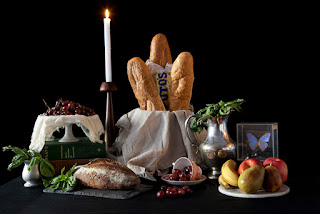Jesus fed the thousands of people who had gathered to hear him teach. With one child's lunch as the starting point, Jesus was able to feed all those people and have leftovers (Matthew 14:13-21). So now Jesus is faced with a problem of the ages...what to do with the leftovers.
Those baskets of leftovers have been assigned different meanings. They may symbolize the abundant life promised by Jesus. Perhaps the leftovers held food that would now provide for the people who had served. The contents of the baskets may be distributed to those in the community who are hungry. The fact that there were leftovers demonstrates Jesus' desire and ability to be generous and lavish, not to barely sustain life. In Mark's gospel, these miraculous feedings were a source of reflection after the fact for the disciples (Mark 8:14-21). Jesus called the disciples to remember the feedings and the leftovers, and then he asked them, "Do you not yet understand?" What do you believe the baskets of leftovers mean?
A quick internet search for "recipes leftovers" yields more than 35,000,000 results. Searching "cookbook leftovers" gives thousands of options to purchase. You can purchase books according to food type (Christmas ham, scraps/peels/stems, chicken, zucchini), purpose (to be thrifty, to be good to the earth, better meal-planning, creativity) or emotional promise (love your leftovers). You may have seen this commercial, currently running. The commercial focuses on food that is wasted every day - less-than-perfect fruit and ugly vegetables, for example. Food that is leftover but not used. What did Jesus do with the baskets of leftovers?
Contemporary artist Aliza Eliazarov crafted the photograph above. In the style of 17th-century Dutch still life painters, she arranged bread and fruits and greenery. If it is true that we eat first with our eyes, then Eliazarov's visually appealing composition is quite satisfying. The white fabric and the vibrant colors of the food (and the blue butterfly at the right), glow against the dark background. The rougher textures of the bread contrast with the smooth surfaces of the cherries. The simple background keeps the focus on the food. But this photo tells us more than the beauty of food. The photograph is from Eliazarov's series called "Waste Not." All the food in this photo was "rescued from curbside garbage in front of Caputo's Bakery and Union Market on Court Street - Cobble Hill, Brooklyn." Take another look at the photo and think about the fact that all of that food had been thrown away. These "leftovers" were thrown away.
What do leftovers mean in Matthew's gospel? What do leftovers mean in our world today?
For Aliza Eliazarov's "Waste Not" series, click here.
For thoughts on Dutch still life painters and Isaiah 55:1-9, click here.
This week on the Art&Faith Matters Facebook page, a look at a new painting of Jacob's wrestling match.



No comments:
Post a Comment